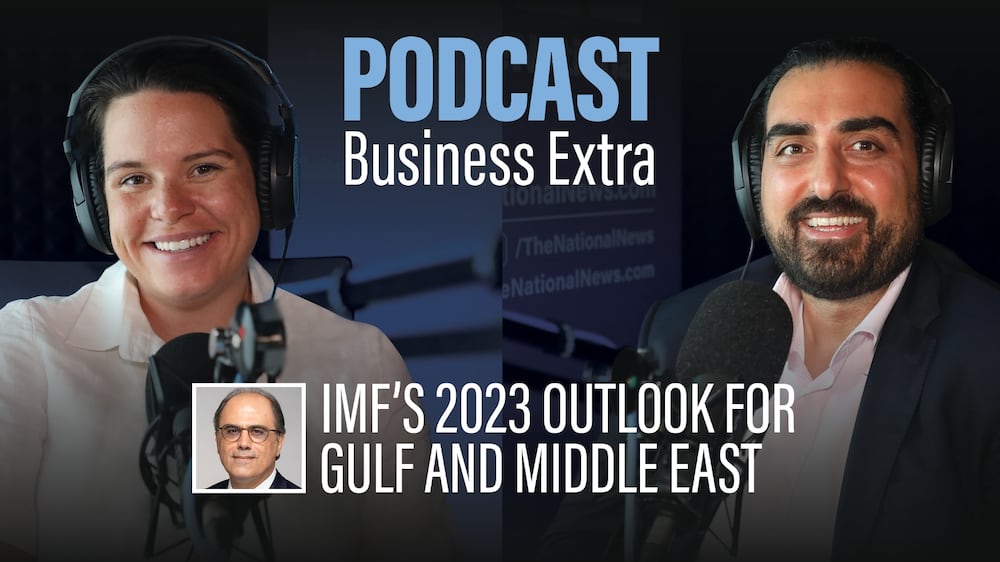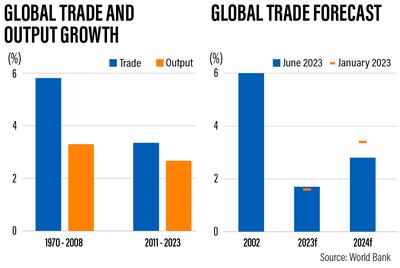The world economy is set to grow at a slower pace as continued monetary policy tightening to rein in inflation is expected to crimp development, the World Bank has said.
Growth has been forecast at 2.1 per cent this year, down from 3.1 per cent last year, before recovering to 2.4 per cent in 2024, the Washington-based lender said in its latest Global Economic Prospects report on Tuesday.
Tight global financial conditions and subdued external demand are expected to weigh on growth across emerging markets and developing economies.
This year's growth projections for these economies are “less than half [of] those from a year ago, making them highly vulnerable to additional shocks”, the World Bank said.
In emerging markets and developing economies other than China, growth is set to slow to 2.9 per cent in 2023, from 4.1 per cent last year.
“The surest way to reduce poverty and spread prosperity is through employment – and slower growth makes job creation a lot harder,” said World Bank President Ajay Banga, who assumed charge on Friday.
“It’s important to keep in mind that growth forecasts are not destiny. We have an opportunity to turn the tide but it will take us all working together.”
Last month, the US Federal Reserve bumped up the policy rate for a third consecutive time this year by 25 basis points to curb inflation and restore price stability.

The Fed has been aggressively increasing interest rates since March last year to tame consumer prices that hit a 40-year high in 2022.
However, it has indicated a potential pause in rate increases amid fears of a recession in the world's largest economy.
The central banks of the UAE, Saudi Arabia, Bahrain, Qatar and Oman all followed suit by raising their benchmark borrowing rates in May.
Global financial conditions have tightened as a result of policy rate increases and recent bouts of financial instability, according to the World Bank.
Many banks experienced substantial unrealised losses due to the sharp rise in policy interest rates, it said.
“Financial markets remain highly sensitive to evolving expectations about the future path of interest rates of major central banks,” the report said.
The latest forecasts indicate that the overlapping shocks of Covid-19, the Ukraine war and the sharp economic slowdown have dealt an enduring setback to development to emerging markets and developing economies, “one that will persist for the foreseeable future”, the World Bank said.
By the end of 2024, economic activity in these economies is expected to be “about 5 per cent below levels projected on the eve of the pandemic”.
“The world economy is in a precarious position,” said Indermit Gill, chief economist and senior vice president at the World Bank.
IMF's 2023 outlook for Gulf and Middle East - Business Extra

With fiscal weaknesses having already tipped many poor countries into debt distress, pressure is growing in emerging markets and developing economies due to higher interest rates, he said.
Growth in the Mena region is expected to slow to 2.2 per cent in 2023, before rebounding to 3.3 per cent in 2024, as inflation and global headwinds subside and oil production rises.
The 23-member Opec+ alliance of oil producers on Sunday said it had set a new production target of 40.46 million barrels per day for 2024.
The alliance has extended its output cuts until the end of 2024 as concerns about economic growth weigh on the outlook for fuel demand.
Saudi Arabia will make an output cut of a million bpd in July, which could be extended if required.
The group has total production curbs of 3.66 million bpd, or about 3.7 per cent of global demand, in place, including a 2 million bpd reduction agreed on last year and voluntary cuts of 1.66 million bpd announced in April.
“The growth outlook for oil exporters in 2024 has improved since January, reflecting an assumed rebound in oil production, the expected effects of reform initiatives, and investment drives in Saudi Arabia and the UAE,” the World Bank said.
The Mena region entered 2023 with “solid growth momentum in oil-exporting economies owing to high oil prices – which had helped these economies grow at a decade-high rate in 2022 – and ongoing recoveries in services sectors”.

Many developing economies are also struggling to cope with weak growth, persistently high inflation and record debt levels, said World Bank deputy chief economist Ayhan Kose.
“Yet new hazards – such as the possibility of more widespread spillovers from renewed financial stress in advanced economies – could make matters even worse for them,” he said.
“Policymakers in these economies should act promptly to prevent financial contagion and reduce near-term domestic vulnerabilities.”
In advanced economies, growth is set to decelerate from 2.6 per cent in 2022 to 0.7 per cent this year and remain weak in 2024, according to World Bank estimates.
After growing by 1.1 per cent in 2023, the US economy is set to slow down to 0.8 per cent in 2024, “mainly because of the lingering impact of the sharp rise in interest rates over the past year and a half”, the report said.

In the euro area, growth has been projected at 0.4 per cent in 2023, down from 3.5 per cent in 2022, due to the lagged effect of monetary policy tightening and energy price increases.
Despite a continued recovery in tourism, global trade growth is also expected to slow this year in view of the continuing rotation of consumption towards services, which tend to be “less trade-intensive”, the World Bank said.
“In 2023, trade will grow at less than a third of its pace in the years before the pandemic,” Mr Gill said.
The World Bank had said in March that global economic growth was expected to slump to a three-decade low by 2030, with the world economy set to reach its “speed limit” – the maximum long-term rate at which it can grow without risking excess inflation.







